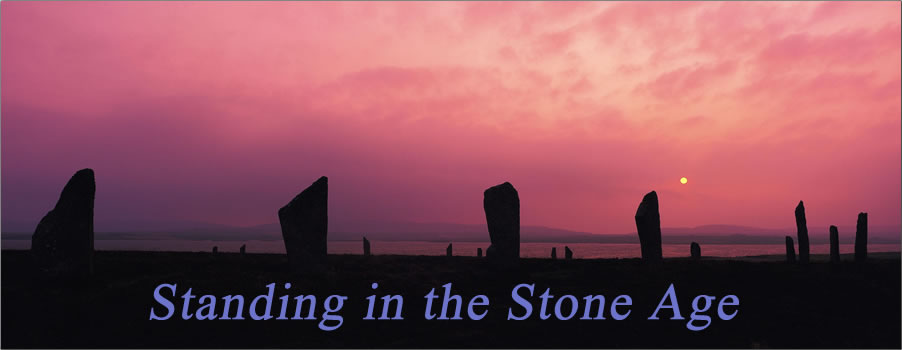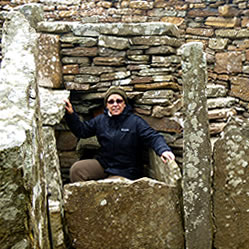
Ring of Brodgar is part of the UNESCO World Heritage Site defined as the Heart of Neolithic Orkney. VisitScotland
Do you have a dream destination that you never seem to get to, just like that book you’re going to write or the ten pounds you’re going to lose? Author, Diane Oates shares how she had always wanted to go to Scotland and one day she finally decided it was time. So what if her husband couldn’t and her friends wouldn’t?
“I’d spent years producing video profiles on athletes and assorted celebrities all over the globe,” she recounts, “so traveling alone should be no problem, right? Except this time I’d be on my own. Undaunted, I hit the Internet and started researching. Inspired by a picture of the 5,000-year-old village of Skara Brae, I decided to go to the Orkney Islands to indulge my inner archeologist. I imagined the site to be filled with the spirit of an ancient people who looked and lived much like us. I wanted to walk where they walked, envision their names and faces, what they wore, what they ate, what they did. So I packed my gear and began the quest.”
 Map: Eric Gaba – Wikimedia Commons user: Sting.
Map: Eric Gaba – Wikimedia Commons user: Sting.
Tossed between the wild Atlantic Ocean and the stormy North Sea, the Orkney archipelago consists of some seventy islands just north of the Scottish mainland. A short flight from Edinburgh took me to the royal burgh of Kirkwall on Mainland, the largest of twenty inhabited islands. It has an airport, is central for island hopping and large enough to have a small variety of hotels and restaurants. This became my base for exploring the ‘Heart of Neolithic Orkney’, named a UNESCO World Heritage Site in 1999.
With only three days to tour, I engaged an excellent local guide, appropriately named Pat Stone, owner of Orkney Aspects. When not showing off her islands to visitors, she helps her husband run a small farm specializing in rare breed pork and prized Orkney lamb. Everyone knows her and she definitely knows her history, as well as the best places to eat! Pat picked me up every morning at the charming West End Hotel, former home of a 19th Century sea captain. From there we worked our way through an itinerary pounded out via e-mails in the months before. Though our plans changed like the Scottish weather, I managed to see everything I wanted to see and more.
![]()

Dating from the early 12th century, Kirkwall’s St. Magnus Cathedral is made of local red sandstone. Diane Oates
In Orkney you can time travel through 5,000 years of history. The sites are scattered over several islands, many of which require a time-consuming ferry crossing, so with limited days, I stuck to Mainland and the nearby South Isles, easily reachable by car. Before starting out on that first morning, it seemed fitting to visit the magnificent St. Magnus Cathedral, which dominates Kirkwall. Begun in 1137 by the Viking Earl Rognvald, the red and yellow sandstone structure seems to glow even on the greyest of grey days.
As we drove along a two-lane highway, I noticed that there were no trees. Low grass, small horses, big cattle, lots of sheep, no trees, but one thing Orkney has is plenty of stone. Walls, buildings, fences, all made from the same raw material used to build legacies lasting thousands of years … like Skara Brae. Inhabited before the Egyptian pyramids, Stonehenge or legendary Troy were built, this semi-subterranean village surpasses anything else in Northern Europe for its state of preservation.

Skara Brae is northern Europe’s best preserved prehistoric village. VisitScotland
A modest entry fee buys an all-access pass to the excavated village and these magnificent buildings linked together by narrow, roofed alleyways. The dwellings had recognizable furniture – dressers, shelving, beds, hearths and amazingly, a rudimentary drainage system suggesting the possibility of indoor toilets. The homes had tank-like enclosures made of vertical slate slabs that archeologists speculate were watertight bait boxes.
I can imagine a roaring peat fire in the hearth and a person perhaps sitting on the very bench where I now perch. I could have stayed all day but Pat pointed to a large grassy mound in the distance. “Maeshowe”, she said. On the short drive there, Pat explained that many area sites could be connected, sketching a complex picture of prehistoric life and afterlife. Maeshowe is one of the world’s finest examples of a chambered tomb, a masonry miracle where massive 30-ton flagstones create a cathedral-like resting place for honored dead.

Maeshowe burial mound is over 5,000 years old. VisitScotland

Maeshowe is one of the world’s finest examples of a chambered tomb or cairn. Charles Tait
Being inside is humbling but not everyone entered this place with reverence. When the Vikings swept through the Orkneys in the 9th century, they often sheltered in these large-chambered cairns and at Maeshowe left behind a carving of a dragon and some surprisingly modern graffiti. Written in Runic symbols, “Thorni bedded, Helgi carved” made me smile. And once the Vikings came, they stayed. According to Orkney historian, folklorist and writer Sigurd Towrie, “For almost 950 years the spoken language in Orkney was a variant of Old Norse known as Norn. Remnants of this now extinct language can still be heard in today’s Orcadian dialect.”

Stones of Stenness. Charles Tait
After Maeshowe, we had just enough light left to visit two of Britain’s oldest henge sites. The timing was perfect – it was the ‘gloaming’, that mystical time between sunset and darkness. Though only four of the original twelve megaliths remain, the 5,200-year-old Standing Stones of Stenness still evoke a vision of what was likely a sacred gathering place, complete with center hearth and altar. The nearby Ring of Brodgar, constructed some 1,000 years later, helps strengthen the belief that the Heart of Neolithic Orkney is part of a ritual landscape.
New discoveries at the nearby Ness of Brodgar are now bearing that out. Excavation Director and archeologist, Nick Card, has speculated that many area sites could be connected in what is emerging as a vast living/temple complex. “The discoveries at the Ness are changing our perceptions of the sophistication of this period,” he says. “They are almost on the scale of some of the great classical sites in the Mediterranean, like the Acropolis in Greece, except these structures are 2,500 years older.”
It’s rainy in New York as I write this and I can’t help but think about Scotland’s fog-shrouded past. The Orkney Islands offer an unforgettable journey to an outpost of ancient civilization with dizzying cliffs pounded by angry seas framing a landscape dotted with burial mounds, pre-historic villages and mysterious megaliths. A land out of time where you will find yourself magically standing in the Stone Age.
![]()
Getting there:
By airline: Flybe from Edinburgh and Glasgow, as well as other UK and European airports.
By ferry: Northlink Ferries; Pentland Ferries; and John O’Groats Ferries.

Staying and touring there:
The small West End Hotel in central Kirkwall is homey with good food and a convivial bar.
Orkney Aspects tour company offers an authoritative, close-up appreciation of the Orkney Islands, an incredible float through history with plenty of fun, food to nourish and food for thought.
Other Resources:
Visit Scotland/Orkney Islands and Historic Scotland,
Run by a multi-generational Orcadian, Orkneyjar is a website dedicated to the preserving, exploring and documenting the ancient history, folklore and traditions of Orkney. It is filled with facts, photos and even a link to a live internet feed from inside Maeshowe tomb.
Caption: The ancient people of the Orkney Islands quarried thousands of tons of fine-grained sandstone to build impressive monuments and structures. VisitScotland
Diane Oates is a six-time Emmy award-winning writer/producer who, when she’s not producing half-hour specials for WABC-TV in New York City, is planning her next adventure. She has traveled extensively for various broadcast and cable networks over a 36-year career working in news, sports and entertainment. Email: Diane2012traveler@gmail.com.

